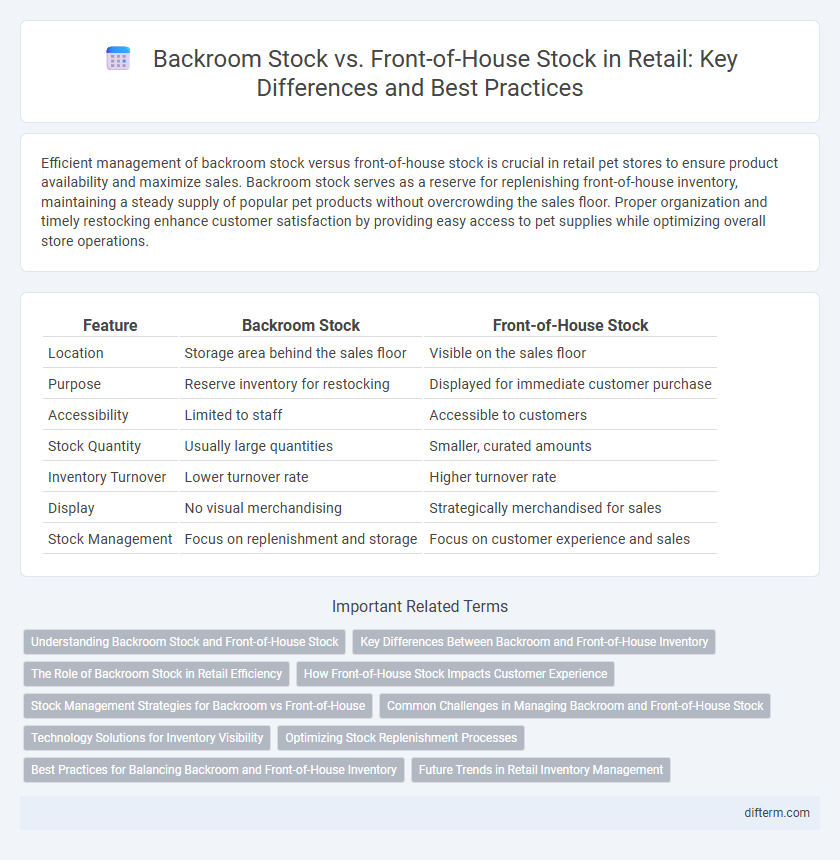Efficient management of backroom stock versus front-of-house stock is crucial in retail pet stores to ensure product availability and maximize sales. Backroom stock serves as a reserve for replenishing front-of-house inventory, maintaining a steady supply of popular pet products without overcrowding the sales floor. Proper organization and timely restocking enhance customer satisfaction by providing easy access to pet supplies while optimizing overall store operations.
Table of Comparison
| Feature | Backroom Stock | Front-of-House Stock |
|---|---|---|
| Location | Storage area behind the sales floor | Visible on the sales floor |
| Purpose | Reserve inventory for restocking | Displayed for immediate customer purchase |
| Accessibility | Limited to staff | Accessible to customers |
| Stock Quantity | Usually large quantities | Smaller, curated amounts |
| Inventory Turnover | Lower turnover rate | Higher turnover rate |
| Display | No visual merchandising | Strategically merchandised for sales |
| Stock Management | Focus on replenishment and storage | Focus on customer experience and sales |
Understanding Backroom Stock and Front-of-House Stock
Backroom stock refers to the inventory stored out of customers' sight, typically in storage rooms or warehouses, ensuring product availability for restocking shelves efficiently. Front-of-house stock comprises items displayed on sales floors, designed for immediate customer access and purchase. Effective management of both backroom and front-of-house stock balances inventory levels, minimizes stockouts, and enhances the overall retail experience.
Key Differences Between Backroom and Front-of-House Inventory
Backroom stock refers to the inventory stored in the retailer's storage area, typically consisting of bulk items, excess merchandise, and seasonal products not immediately needed on the sales floor. Front-of-house stock includes the products displayed on shelves and racks accessible to customers, emphasizing high-demand, frequently purchased items for immediate sale. Key differences lie in accessibility, with backroom stock supporting inventory replenishment and front-of-house stock driving direct sales and customer engagement.
The Role of Backroom Stock in Retail Efficiency
Backroom stock plays a crucial role in retail efficiency by ensuring that front-of-house shelves remain fully stocked without interruptions, enhancing the customer shopping experience. Efficient management of backroom inventory reduces stockouts and allows for quicker restocking, minimizing downtime on the sales floor. Retailers leveraging real-time inventory tracking and organized backroom layouts achieve higher sales and improved operational productivity.
How Front-of-House Stock Impacts Customer Experience
Front-of-house stock directly influences customer experience by ensuring product availability and visual appeal, which encourages immediate purchases and reduces frustration. Strategically organized front-of-house inventory enhances store aesthetics and accessibility, creating a more engaging and seamless shopping environment. Efficient front-of-house stock management also minimizes out-of-stock situations, thus maintaining customer satisfaction and loyalty.
Stock Management Strategies for Backroom vs Front-of-House
Effective stock management strategies differentiate between backroom and front-of-house stock by prioritizing accessibility and turnover rates. Backroom stock requires systematic organization and real-time inventory tracking to enable rapid replenishment and prevent overstocking, while front-of-house stock emphasizes visual appeal and immediate availability to enhance customer experience. Integrating technology such as RFID and inventory management software optimizes stock levels, reduces shrinkage, and aligns supply with consumer demand in both areas.
Common Challenges in Managing Backroom and Front-of-House Stock
Managing backroom stock involves challenges such as limited storage space, difficulty in maintaining accurate inventory counts, and ensuring timely replenishment to front-of-house displays. Front-of-house stock requires constant monitoring to balance product availability with aesthetic presentation and customer accessibility, often complicated by frequent sales fluctuations. Both areas face the risk of misalignment, leading to stockouts or overstock situations that can impact overall retail performance and customer satisfaction.
Technology Solutions for Inventory Visibility
Advanced inventory management systems integrate RFID and IoT technology to provide real-time visibility of both backroom stock and front-of-house stock, reducing discrepancies and stockouts. Cloud-based platforms offer detailed analytics and automatic replenishment alerts, optimizing stock levels across all store areas. Mobile scanning tools enhance accuracy during stocktaking and streamline communication between backroom and sales floor teams.
Optimizing Stock Replenishment Processes
Optimizing stock replenishment processes between backroom stock and front-of-house stock enhances inventory accuracy and minimizes out-of-stock situations in retail environments. Efficient data integration using real-time sales and inventory management systems allows for precise demand forecasting and timely restocking of front-facing products. Streamlined communication between warehouse operations and sales floors reduces delays, improves customer satisfaction, and maximizes sales potential.
Best Practices for Balancing Backroom and Front-of-House Inventory
Efficient retail inventory management requires maintaining an optimal balance between backroom stock and front-of-house stock to ensure product availability and minimize stockouts. Best practices include implementing real-time inventory tracking systems, using demand forecasting to allocate appropriate stock levels in both areas, and scheduling regular audits to prevent overstocking or obsolescence. Leveraging omnichannel inventory visibility helps retailers respond swiftly to customer demand while optimizing storage space and reducing carrying costs.
Future Trends in Retail Inventory Management
Advancements in AI-powered inventory management systems are transforming the balance between backroom stock and front-of-house stock, enabling retailers to optimize product availability while minimizing overstock. Increasing use of IoT sensors and real-time data analytics allows seamless integration between storage areas and sales floors, ensuring dynamic replenishment based on consumer demand patterns. Smart shelving and automated stock rotation technologies are forecasted to enhance inventory accuracy, reduce waste, and improve overall retail efficiency.
Backroom Stock vs Front-of-House Stock Infographic

 difterm.com
difterm.com